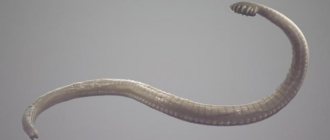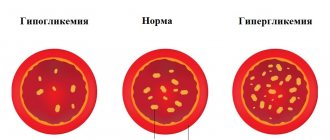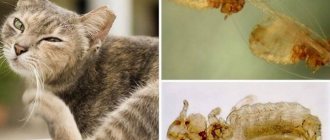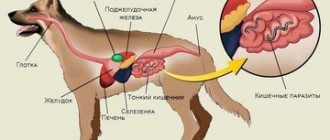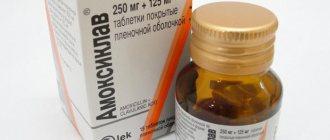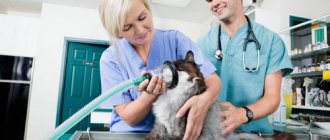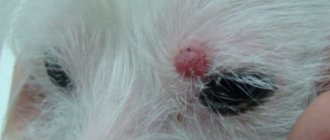Due to its rapid development, salmonellosis, or paratyphoid, in cats can cause their sudden death. Kittens suffer from this disease especially hard.
In some situations, to save an animal you have to provide first aid right at home. For this reason, it will be very useful for all owners of mustachioed pets to learn its basics and the symptoms of the pathology itself, which should be paid attention to.
All about the pathogen and the disease
The causative agent of paratyphoid fever is the rod-shaped bacteria Salmonella. They are highly resistant to adverse environmental factors.
Depending on temperature conditions, bacteria found outside a living organism retain their pathogenicity and viability from 4 months to 1 year. To destroy them, heat above 75°C, ultraviolet rays and disinfectants are used.
After entering the body, salmonella begins to actively multiply. In the process of their life, they release a large amount of toxins that inhibit the functioning of internal organs. Over time this leads to:
- degenerative and necrotic changes in the liver, spleen, kidneys, intestines, lungs and joints;
- internal hemorrhages;
- the development of sepsis, that is, blood poisoning.
The main damage occurs in the gastrointestinal tract. Because of this, the first symptoms are often mistaken for poisoning or feline distemper.
Causes of the disease
Feline salmonellosis is a bacterial intestinal infection caused by bacteria of the Salmonella genus. Doctors identify 20 different pathogens that can cause this disease.
Below are the main causes of the disease in cats.
- Eating raw meat contaminated with salmonella or poorly cooked cat food.
- Contact with an infected animal. A kitten can contract the disease from another cat. Older animals are less susceptible to this disease.
- Infection of kittens through the placenta can occur if an acute disease develops in the mother cat. The kitten may be born with congenital anomalies or dead.
- Eating rodents. Mice and rats can be carriers and transmitters of salmonellosis.
Causes and routes of infection
The main cause of infection is neglect of the rules for the care and maintenance of pets. The bacterium enters the body in the following ways:
- Fecal-oral.
Transmission occurs by eating contaminated food or sniffing or ingesting feces. Risk factors include regular feeding of raw meat and unboiled milk, as well as hunting birds and mice.
- Vertical.
An ill mother can pass salmonellosis to her babies through the placenta. In this situation, pregnancy is often complicated by miscarriages and stillbirths.
- Contact.
The cause of the disease can be interaction with the personal belongings of an infected person or stroking with dirty hands.
The risk group includes kittens, residents of cat shelters, elderly animals and animals weakened by chronic diseases. What they all have in common is very low immunity, unable to fight off infection.
Features of the clinical picture
Salmonellosis in cats can occur in acute, subacute and chronic forms. The first symptoms may occur within the first two days after contact with an infected animal or consumption of infected meat.
The main clinical manifestations of salmonellosis include the following symptoms:
- anorexia – refusal to eat. The animal refuses to eat the food offered to it;
- increase in body temperature to 41 degrees. A sick cat has a hot and dry nose;
- nausea and repeated vomiting. Vomit may consist of food debris, bile, gastric juice, hairballs;
- weakness, which is manifested by inactivity of the pet. The cat constantly lies down, sleeps, and does not walk around the house;
- profuse diarrhea. The stool may have a foul odor, foam, and streaks of blood and mucus can be seen in it. The animal goes to the toilet often, up to 15 times a day;
- A decrease in the amount of urine occurs due to dehydration of the cat.
Main symptoms
The main symptoms of salmonellosis in cats include diarrhea and dehydration, which are very difficult to ignore. But its characteristic leukocytosis, that is, an increase in the natural level of leukocytes, can only be detected in a blood test.
Incubation period
The duration of the incubation period depends on the strength of the immune system and ranges from 2 to 15 days. Until this point, infection can only be determined through laboratory tests.
Three forms of disease development
According to the severity and speed of development, salmonellosis is divided into 3 forms. These include:
- Spicy.
Develops in kittens or adults at high concentrations of the pathogen. Body temperature rises to 42°C, causing severe weakness and worsening appetite. The condition is aggravated by foul-smelling mucous diarrhea and vomiting with pieces of bile and undigested food. Purulent discharge appears from the eyes, and the mucous membranes turn pale. In especially severe cases, symptoms are supplemented by difficulty breathing, convulsions and coma.
- Subacute.
It is similar to the acute form, but differs in a less rapid increase in dehydration and a slightly lower temperature within 40°C.
- Chronic.
It manifests itself with only one or several symptoms characteristic of the disease, gradually depleting the body’s strength. At an advanced stage, a sick animal exhibits pronounced signs of anemia: deterioration in the quality of the coat, a decrease in body temperature, loss of consciousness, pale or blue discoloration of the mucous membranes.
Without timely assistance, death in the acute form occurs already 2-3 days after the onset of symptoms. In the subacute form, this time extends to 7-15 days, and in the chronic form – up to 15-30 days.
Prevention to combat salmonellosis in cats
Owners of four-legged friends should remember that salmonellosis is transmitted from cat to person, so precautions must be taken when caring for and treating an infected animal. Regularly treating your pet's area with disinfectants and thoroughly washing your hands with soap after each interaction with your pet will help prevent the transmission of infection.
Advice from the doctor! During treatment for salmonellosis, it is very important to increase the protective properties of the cat’s body, so sick animals require immunostimulating drugs. In addition, owners of furry creatures are obliged to improve the quality of life of their pet. The cat needs proper care (keep the animal clean, provide high-quality and balanced nutrition).
Sick cats are kept separately from healthy pets, and care items and equipment for infected cats are disinfected. Pregnant and lactating females are provided with high-quality food; kittens are introduced to new complementary foods with great care and gradually.
Salmonellosis is a serious infectious disease that poses a mortal danger to your four-legged friend. If you suspect a cat has a gastrointestinal disorder, you cannot hope that the ailment will go away on its own; you need to check the cat for salmonellosis. Only timely contact with a specialist will help avoid the death of your pet.
Salmonellosis in cats is a common disease. An animal can become infected with it from infected fresh meat. This intestinal infection is most dangerous for kittens. In this article, we reviewed the main causes, symptoms, methods of diagnosis and treatment of salmonellosis in cats.
Salmonella danger
Bacteria are dangerous not only for cats, but also for other pets and their owners. For this reason, during treatment, the patient should be isolated in a separate room, excluding contact with other household members.
For a cat
Infection in kittens is often fatal due to the development of acute renal, liver or pulmonary failure. In adult animals, the cause of death is complicated pancreatitis, severe dehydration (loss of 20-25% of fluid) and infectious-toxic shock.
For humans and other animals
Owners are usually infected through contact, and their pets through the fecal-oral route. In the second case, the likelihood of infection increases when several animals use one tray.
In addition to isolating the patient, you will need to disinfect all his personal belongings, as well as regularly wash your hands after each direct contact and cleaning up feces. During treatment, the cat's bowls and tray should be placed in the quarantine area.
Please note that the feces of a recovered animal will contain pathogenic bacteria for some time. For this reason, stool analysis will have to be periodically checked for their presence. It will be possible to remove isolation only after receiving negative results for salmonella.
Prevention
To prevent an animal from becoming infected with salmonellosis, healthy cats should not be allowed to come into contact with sick ones. It is necessary to regularly disinfect the premises, equipment, and care items.
To prevent the disease, it is important to provide adequate nutrition, carry out timely treatment of colds, gastrointestinal pathologies, and periodically use anthelmintic medications.
Animals that walk outside, eat mice, and often consume fresh meat must undergo timely vaccination. It is also necessary to vaccinate small kittens under 2 months of age.
To prevent human infection, after contact with a sick animal, you must thoroughly wash your hands and follow other sanitary and hygienic rules. If there are children in the family, they should not be allowed to interact with a sick cat.
Salmonellosis in cats is an infectious disease that affects the gastrointestinal system. Mostly kittens aged 1 to 2 months are affected, but in some cases the infection is also diagnosed in adult animals. Signs of salmonellosis are similar to manifestations of severe poisoning, helminthic infestation, and other infectious and viral diseases. Only a doctor can make an accurate diagnosis, based on the clinical picture and laboratory diagnostics. It is difficult to recognize the disease on your own. In the absence of qualified treatment, infected cats and kittens die from severe intoxication and exhaustion of the body.
First aid at home
If you cannot deliver your pet to the veterinary clinic within an hour, give him first aid. It consists in removing the level of intoxication and extending the time allotted for rescue in case of acute salmonellosis.
Washing and administering an enema
First of all, you need to rinse your stomach. To do this, mix 20-40 ml of water with a couple of pinches of salt and pour it into the cat's mouth using a syringe without a needle. After this, gently press on the root of the tongue, stimulating the gag reflex.
The enema procedure is also very simple. You need to fill a 50-100 ml baby bulb with water and carefully insert it into the cat's anus, lubricated with Vaseline or greasy cream. This procedure should be repeated after each bowel movement until the water coming out of the anus is clear.
What medications can be used
To neutralize toxins, it is recommended to use sorbents - Polysorb, Enterosgel, Smecta or activated carbon. The dosage of these drugs depends on weight, but all information can be easily found from the instructions inside the package. If you are in doubt, contact your veterinarian by phone and they will tell you the optimal dose of medication for your animal.
Fasting and drinking
Feeding a sick animal is strictly prohibited, but in its condition the presence of appetite is rather an exception. But drinking plenty of water is welcome. It helps prevent dehydration and reduce the concentration of harmful substances.
To avoid new attacks of vomiting, give your pet no more than 5-10 ml of water at a time. This is conveniently done through a syringe at intervals of 15 minutes.
Sources of infection
- after eating milk or raw meat of infected farm animals or birds;
- when eating other contaminated food, eggs, fish;
- from cats – carriers of infection through contact with their feces;
- after contact with other infected animals - rodents, birds;
- due to improper care and non-compliance with hygiene rules;
- due to reduced immunity during the period of teeth change, due to past diseases of the gastrointestinal tract, the presence of worms;
- in kittens in utero through the placenta from a sick pregnant cat.
- keep the cat and kittens clean, always follow the rules of hygiene for them, give them only clean water to drink;
- exclude contact of your pet with street animals;
- include meat in the diet, the quality of which is beyond doubt;
- for preventive purposes, it is advisable to heat treat meat, milk and eggs;
- do not allow a sudden change from one food to another in the first days of feeding kittens;
- Buy industrial feed only of good quality.
The main cause of infection is the consumption of meat and fish that have not been previously subjected to heat treatment. Low-quality specialized food intended for cats may also contain salmonella.
You can also become infected through contact with other types of animals that have the infection, these include:
- mice or rats;
- birds;
- chickens;
- ducks;
- geese
In addition to the above, the etiology of the disease is:
- failure to comply with hygiene rules;
- viral diseases;
- intestinal diseases caused by poor diet.
The effect of factors is aggravated during the period of change of teeth from milk to permanent ones, during infection with worms, during the transition from mother's milk to specialized cat food that does not meet all standards.
The more often your pet receives raw food, the higher the likelihood of infection. The same applies to cases where an animal receives feed of unsatisfactory quality and/or of dubious origin. If in a bag of dry food you find pellets that are not very similar to food granules, but strongly resemble mouse droppings... In a word, you should not feed your pets this.
Diagnosis and treatment
The main method of treatment is antibiotic therapy, so it is very important not to confuse salmonellosis with diseases with similar symptoms. To make a diagnosis and determine the exact type of pathogen, it is necessary to donate blood for bacterial culture.
Unlike other pathogens, salmonella are detected quite quickly in the nutrient medium. The result of the analysis comes within 24 hours, which allows you to avoid death even in the acute form.
Additionally, an ultrasound may be required to assess the extent of damage to internal organs. A general and biochemical blood test is also mandatory.
Elimination of the pathogen
Salmonellosis in cats is treated with sulfonamide drugs and tetracycline antibiotics. The average duration of their use is a week, and the entire recovery period takes about 2 weeks.
In especially severe cases, the pet is left in the hospital for a couple of days. After the condition has stabilized, it is handed over to the owner, along with recommendations for eliminating the remaining consequences.
Elimination of consequences
Antibacterial drugs cause a serious blow not only to the pathogen, but also to the entire body. Because of this, they are taken in combination with probiotics, hepatoprotectors, glucocorticosteroids and antihistamines.
Signs of dehydration caused by vomiting and diarrhea are treated with rehydration drips. They restore the natural amount of microelements and cleanse the body of harmful substances remaining in it.
Diet
Recovery is not complete without a gentle diet, excluding the presence of solid and fatty foods. The usual diet is changed in favor of liquid and pureed dishes that do not overload the affected stomach and intestines.
The digestion process is facilitated by fractional feeding. Thanks to small but frequent meals, the body does not have time to get hungry or experience overload.
In addition, the veterinarian may recommend several medications to strengthen the immune system and replenish missing microelements. Only those who eat dry food do not need additional vitamins. It is enough to switch them to wet canned food and dry granules from a special line designed for animals with gastrointestinal diseases.
Diagnosis of salmonellosis in a cat
To make an accurate diagnosis, a clinical examination of the animal is not enough; laboratory diagnostics are necessary. To identify the pathogen, a study of the feces of a sick pet is carried out; in case of a post-mortem diagnosis, it is necessary to conduct a bacteriological culture from the parenchymal organs of a dead cat.
The differential diagnosis excludes diseases such as canine distemper, helminthic infestation, influenza, intoxication with chemical and toxic substances, and viral gastroenteritis.
Is salmonellosis scary for people?
All pet owners need to know that salmonellosis is a common disease of humans and animals, so both a person and an animal can become infected, and vice versa. Therefore, the owner of a sick animal needs to take this very seriously, namely, follow all hygiene rules while caring for the cat.
Always wash your hands with soap and water before eating and when caring for an infected animal. To avoid infection, it is better not to squeeze your pet; you should wait until it recovers.
Salmonellosis is transmitted to humans from cats through direct contact.
All pet owners need to know that salmonellosis is a common disease of humans and animals, so both a person and an animal can become infected, and vice versa. Therefore, the owner of a sick animal needs to take this very seriously, namely, follow all hygiene rules while caring for the cat.
What should you know about salmonellosis?
Salmonellosis
– a disease caused by gram-negative facultative anaerobic bacteria belonging to the genus Salmonella. Species such as Salmonella paratyphi and Salmonella typhi, which cause “typhoid-like” forms of the disease, pose a danger to humans.
In addition, there are many types of salmonella that pose a danger to animals. They enter the body with contaminated food or water. Thus, in cats, salmonellosis can occur as a result of eating raw contaminated meat, milk and eggs, or contact with the feces of sick animals. Quite often, outbreaks of salmonellosis among cats occur in areas located near poultry houses, farms, meat processing plants, slaughterhouses, and burial sites for animal remains.
Diagnosis of feline infectious salmonella
How to detect feline salmonellosis? It is impossible to diagnose the disease using clinical indicators alone. The diagnosis is made by taking a clinical blood and urine test.
If salmonellosis is suspected, the veterinarian will draw blood.
In addition, serology of the blood of a sick animal is necessary. Only after an epizootological, clinical and pathological examination can an accurate diagnosis be made. At the end of the diagnosis, stool is examined in a laboratory for the presence of salmonellosis.
Incubation period and development of the disease
The consequences of salmonellosis include dehydration, which develops against the background of diarrhea and vomiting. The possibility of pancreatitis, which is inflammation of the pancreas, cannot be ruled out. Sometimes kidney failure develops, to which young pets are most susceptible. Due to infection, the organ stops purifying the blood.
We suggest you read: Why does a British cat snore? Does your cat snore? The first signs of disease
It is important to remember that salmonellosis is an anthropozoonosis. Simply put, by squeezing your furry, you yourself can become infected. The danger of this infection also lies in the fact that at least a third of cats (and dogs) do not show any symptoms at all, being classic carriers. If the infection “attacks” a cat with a weak immune system, then its manifestations will definitely not take long to appear. What are the symptoms of salmonellosis in cats?
Here are the main ones:
- Severe fever of intermittent type.
- Poor appetite or complete absence of it.
- Coma or lethargy.
- Severe profuse diarrhea, with feces often black from digested blood.
- Whenever you try to feel the stomach, the cat immediately begins to hiss and otherwise express its displeasure.
- Rapid development of sepsis. This is due to the fact that Salmonella toxins greatly increase the permeability of the intestinal walls, as a result of which pathogenic and conditionally pathogenic microflora can enter the general bloodstream.
This disease is especially dangerous if it affects kittens. They very quickly fall into apathy, their eyes droop literally within a few hours, their body temperature rises sharply, profuse diarrhea may begin, but diarrhea is not recorded in all cases of salmonellosis.
Who can your pet get infected from? Cats can serve as carriers of salmonellosis without being sick themselves. But almost all other types of domestic animals, including cattle, can “work” with them. Reptiles, especially turtles, also suffer from salmonellosis and can be its carriers.
Toxins accumulate in the body and affect the vessels of the intestinal wall, increasing its permeability. If the cat's body has insufficient resistance, endotoxins:
- cause areas of hemorrhage on the mucous membranes;
- provoke degenerative changes in organs - intestines, liver, kidneys, spleen;
- penetrate the body’s lymphatic system and general bloodstream, causing the development of sepsis - blood poisoning;
- affects all organs and systems - the brain, joints, lungs.
When bacteria infect all organs and tissues of the body, liver, kidney, and pulmonary failure develops and the death of the animal occurs.
The incubation period after infection ranges from several days to three weeks. The appearance of the first signs of manifestation may be acute or resemble the malaise of mild poisoning. It depends on the age of the pet. The infection is extremely dangerous for kittens, as they tolerate it extremely hard and can die on the second day of illness.
The disease is extremely contagious. If there are other pets in the house besides the cat, they must be isolated. In dogs, the symptoms that occur when infected are the same.
The course of the disease, its severity and the form of salmonellosis depend on the stability of the cat’s immunity.
Forms of the disease
There are acute forms of the disease, subacute and chronic.
The acute form develops when a large number of bacteria - pathogens and their toxins - enter the body. It is characterized by:
- a rapid rise in temperature to very high levels. It remains high throughout the entire period of illness;
- complete refusal of food;
- almost continuous watery diarrhea, vomiting;
- purulent discharge from the eyes and nose;
Vomiting is preceded by hypersalivation. Feces may contain blood and mucus.
Frequent vomiting and profuse diarrhea threaten dehydration and severe intoxication. In this condition, the animal may die already on the second day after the onset of salmonellosis.
The subacute form develops with the same symptoms only of less intensity. Dehydration may not occur as quickly as during an acute infection.
The chronic form of salmonellosis depletes the animal's body. When poisoned by bacterial waste products, purulent conjunctivitis, pneumonia, and anemia develop. Death can occur within a month after the onset of the disease.
